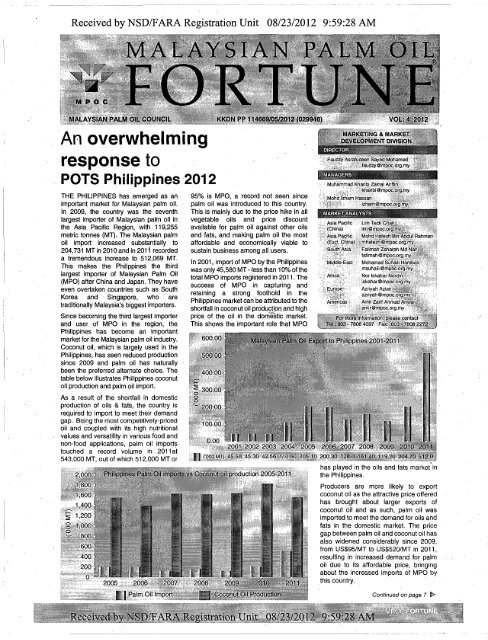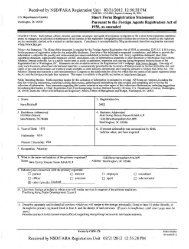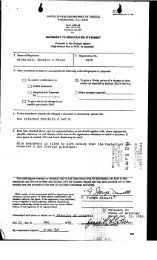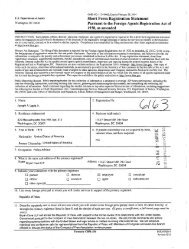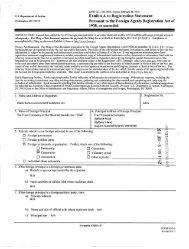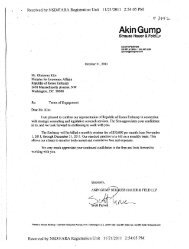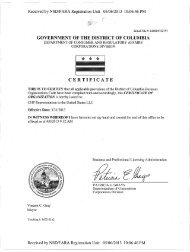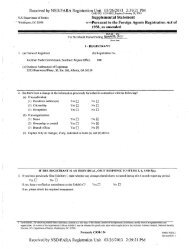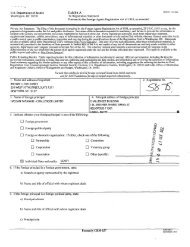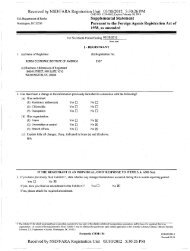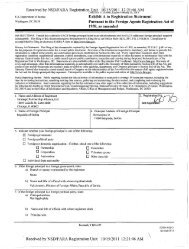Supplemental Statement - FARA
Supplemental Statement - FARA
Supplemental Statement - FARA
You also want an ePaper? Increase the reach of your titles
YUMPU automatically turns print PDFs into web optimized ePapers that Google loves.
Received by NSD/<strong>FARA</strong> Registration Unit 08/23/2012 9:59:28 AM<br />
MALAYSIAN PALM OIL<br />
- FORTUNE<br />
M P O C<br />
MALAYSIAN PALM OIL COUNCIL KKDN PP 114669/05/2012 (0299-16) VOL: 4 2012<br />
An overwhelming<br />
response to<br />
POTS Philippines 2012<br />
THE PHILIPPINES has emerged as an<br />
important market for Malaysian palm oil.<br />
In 2009, the country was the seventh<br />
largest importer of Malaysian palm oil in<br />
the Asia Pacific Region, with 119,255<br />
metric tonnes (MT). The Malaysian palm<br />
oil import increased substantially to<br />
204,731 MT in 2010 and in 201 i recorded<br />
a tremendous increase to 512,069 MT.<br />
This makes the Philippines the third<br />
largest importer of Malaysian Palm Oil<br />
(MPO) after China and Japan. They have<br />
even overtaken countries such as South<br />
Korea and Singapore, who are<br />
traditionally Malaysia's biggest importers.<br />
Since becoming the third largest importer<br />
and user, of MPO in the region, the<br />
Philippines has become an important<br />
market for the Malaysian palm oil industry.<br />
Coconut oil, which is largely used in the<br />
Philippines, has seen reduced production<br />
since 2009 and palm oil has naturally<br />
been the preferred alternate choice. The<br />
table below illustrates Philippines coconut<br />
oil production and palm oil import.<br />
As a result of the shortfall in domestic<br />
production of oils & fats, the country is<br />
required to import to meet their demand<br />
gap. Being the most competitively-priced<br />
oil and coupled with its high nutritional<br />
values and versatility in various food and<br />
non-food applications, palm oil imports<br />
touched a record volume in 2011 at<br />
543,000 MT, out of which 512,000 MT or<br />
2.000<br />
1.800<br />
1.600<br />
1.400<br />
1,200<br />
1,000<br />
800<br />
600<br />
400<br />
200<br />
95% is MPO, a record not seen since<br />
palm oil was introduced to this country.<br />
This is mainly due to the price hike in all<br />
vegetable oils and price discount<br />
available for palm oil against other oils<br />
and fats, and making palm oil the most<br />
affordable and economically viable to<br />
sustain business among all users.<br />
In 2001, import of MPO by the Philippines<br />
was only 45,580 MT - less than 10% of the<br />
total MPO imports registered in 2011. The<br />
success of MPO in capturing and<br />
retaining a strong foothold in the<br />
Philippines market can be attributed to the<br />
shortfall in coconut oil production and high<br />
price of the oil in the domestic market.<br />
This shows the important role that MPO<br />
600.00<br />
500.00<br />
400.00 f<br />
300.00<br />
' 200.00<br />
«»<br />
ZT


